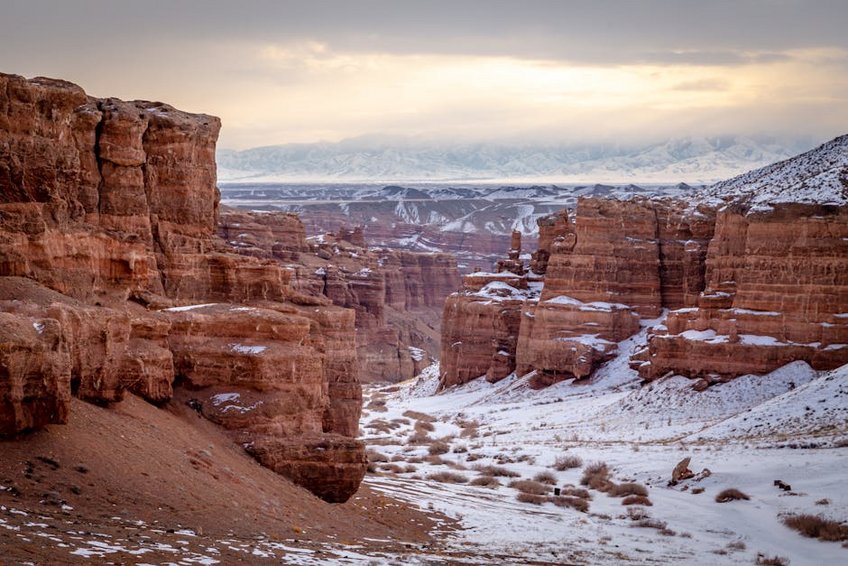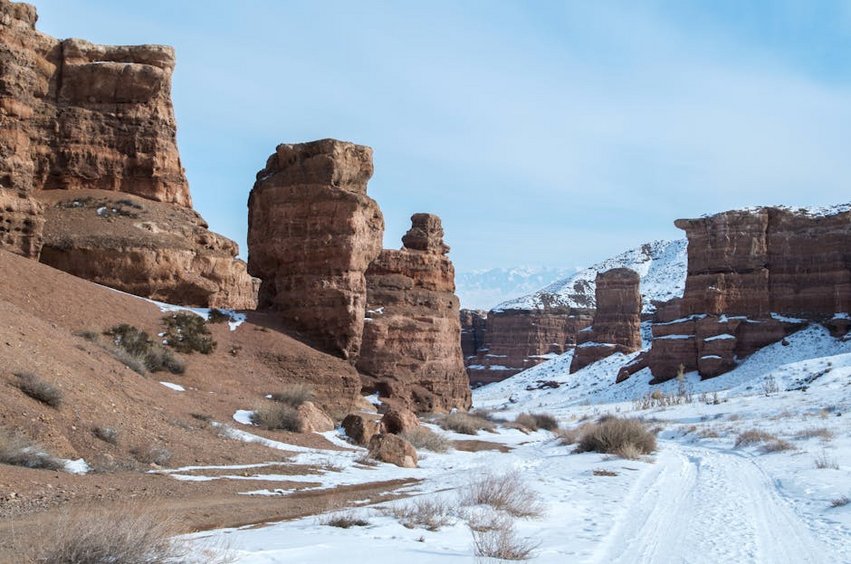Kazakhstan Charyn Canyon Winter Adventure Guide
Exploring Kazakhstan’s Charyn Canyon during winter reveals a stark, beautiful landscape where snow-dusted red rock formations create a photographer’s paradise under crisp blue skies. This Central Asian gem offers serene hiking trails, minimal crowds, and unique ice formations along the Charyn River, with temperatures ranging from 14°F to 32°F (-10°C to 0°C) from December through February. This guide covers essential planning tips, budget considerations, and insider advice for maximizing your winter canyon experience safely and memorably.
Essential Charyn Canyon Information
Charyn Canyon stretches approximately 90 miles (150 kilometers) through southeastern Kazakhstan, forming part of the Charyn National Park established in 2004. The canyon’s distinctive red sandstone layers date back over 12 million years, creating dramatic valleys often compared to a miniature Grand Canyon. Winter transforms this arid landscape into a quiet, frosty wonderland with unique photographic opportunities.
The canyon’s Valley of Castles section features the most impressive rock formations, with towering pillars and intricate shapes carved by wind and water erosion. Located about 120 miles (200 kilometers) east of Almaty, the canyon sits at elevations between 2,000 and 3,000 feet (600-900 meters) above sea level. December through February brings the coldest conditions, with occasional snowfall accumulating 2-4 inches (5-10 cm) in protected areas.
Geographical Location and Access
Charyn Canyon’s remote location requires careful transportation planning, particularly during winter months when road conditions can change rapidly.
- The canyon lies within Charyn National Park in Kazakhstan’s Almaty Region, approximately a 3-4 hour drive from Almaty via the A351 highway.
- Winter access typically requires a 4WD vehicle due to potential ice and snow on the final 12 miles (20 km) of unpaved road leading to the main viewpoints.
- Entry fees for foreign visitors cost approximately $5 per person, with the park operating from 9 AM to 6 PM daily, though winter daylight hours are shorter.
- Budget travelers spend $40-60 daily using shared transportation from Almaty ($15-20 roundtrip), basic guesthouses ($20-30 nightly), and self-catered meals ($10-15 daily). This approach requires bringing your own winter clothing and planning independent hikes.
- Mid-range visitors allocate $80-120 per day for private transfers ($50-70), comfortable hotels in nearby towns ($40-60), restaurant meals ($20-30), and occasional guided hikes ($30-50). This budget includes rental of specialized winter gear like insulated boots.
- Luxury experiences cost $200-350 daily featuring private 4WD vehicles with drivers ($100-150), premium accommodation ($80-120), guided photography tours ($70-100), and heated camp meals. This option provides maximum comfort and specialized winter equipment.
- Kazakhstan Tourism Official Website
- Lonely Planet Kazakhstan Travel Guide
Winter Climate and Conditions
Charyn Canyon’s continental climate creates extreme seasonal variations, with winter temperatures frequently dropping below freezing from late November through March. Daytime highs typically reach 28-32°F (-2 to 0°C) in December and January, while nighttime temperatures plummet to 14-18°F (-10 to -8°C). The area receives limited precipitation, with an average of 4-6 snowy days monthly creating a thin white layer over the red rock.
Wind chill presents the most significant challenge, with gusts accelerating through canyon passages and making temperatures feel 10-15°F (5-8°C) colder. January records the coldest conditions, with occasional periods where temperatures drop to 5°F (-15°C) during extreme cold snaps. Meanwhile, December and February offer slightly milder conditions with more predictable weather patterns for planning visits.
Historical and Geological Significance
Charyn Canyon’s geological history spans approximately 12 million years, with the distinctive red sandstone formations resulting from sedimentary deposition during the Neogene period. The canyon depth reaches up to 1,000 feet (300 meters) in sections, exposing multiple rock layers that reveal the region’s ancient environmental changes. Fossil discoveries in the area include prehistoric flora and fauna specimens preserved in the sedimentary rock.
The Charyn River continues to shape the canyon today, though winter reduces its flow significantly, sometimes creating fascinating ice formations along its banks. Indigenous peoples have inhabited the surrounding regions for centuries, with the canyon serving as a seasonal route for nomadic tribes. Modern conservation efforts began in the 1960s, culminating in the area’s designation as a national park in 2004 to protect its unique ecosystem.

Alt: “charyn-canyon-winter-snow-red-rock-formations”
Planning Your Kazakhstan Charyn Canyon Winter Trip
Organizing your Kazakhstan Charyn Canyon winter adventure requires attention to seasonal challenges, specialized gear, and flexible scheduling to accommodate unpredictable weather. Winter visits between December and February offer solitude and dramatic landscapes but demand thorough preparation for cold temperatures and limited services. You should allocate 2-3 full days for a comprehensive experience, including travel time from Almaty and contingency for weather delays.
Budget approximately $50-80 per day for basic independent travel, covering transportation, meals, and accommodation, though guided tours range from $150-300 daily including specialized winter equipment. The canyon’s remote location means limited cellular service beyond main viewpoints, requiring offline maps and communication plans. Additionally, winter daylight lasts only 6-8 hours, necessitating early starts to maximize exploration time.
Essential documentation includes a valid passport with at least six months remaining, while most Western visitors don’t require visas for stays under 30 days. Travel insurance with emergency evacuation coverage proves crucial for winter visits, as medical facilities remain distant from the canyon area. Booking accommodations and transportation several weeks in advance ensures availability during the short winter season.
Best Time to Visit Charyn Canyon
Mid-December through February represents peak winter conditions at Charyn Canyon, with the most reliable snow coverage and photographic opportunities during this period. Daytime temperatures typically range from 25-32°F (-4 to 0°C) in December, dropping to 20-28°F (-7 to -2°C) in January, then warming slightly to 28-35°F (-2 to 2°C) by late February. Crowds remain minimal throughout winter, though weekends see slight increases in local visitors.
February typically offers the best balance of winter scenery and manageable conditions, with slightly longer daylight hours and reduced extreme cold compared to January. Early December provides opportunities for photography before heavy snow accumulation, while March begins the transition to spring with melting snow and increasing visitor numbers. For optimal photography, visit during early morning or late afternoon when low-angle light enhances the canyon’s textures and colors.
Budget Planning and Costs
Winter travel to Charyn Canyon accommodates various budget levels, though costs increase for specialized cold-weather gear and guided experiences.
Essential Preparation Checklist
Winter visits demand specific gear to handle temperatures that regularly drop below freezing, particularly during early mornings and evenings. Essential clothing includes thermal base layers, insulated waterproof jackets, fleece mid-layers, winter hiking boots with grip soles, wool socks, gloves, and warm hats. Photography equipment requires extra batteries (which drain faster in cold), lens cloths to prevent condensation, and protective cases.
Health preparations should include consulting your doctor about altitude considerations, packing a comprehensive first-aid kit, and arranging travel insurance with medical evacuation coverage. Documentation needs involve carrying your passport, printed accommodation confirmations, emergency contacts, and offline maps since cellular service remains unreliable in the canyon. Book accommodations and transportation at least three weeks before your visit, particularly for December and January dates.
Top Winter Attractions and Activities
Charyn Canyon’s winter transformation creates unique experiences unavailable during other seasons, with frozen waterfalls, snow-dusted rock formations, and peaceful hiking trails. The Valley of Castles remains the primary attraction, where morning frost highlights the intricate shapes of sandstone pillars rising up to 500 feet (150 meters) high. Winter sunlight angles create dramatic shadows and highlights across the red rock, offering exceptional photography conditions throughout the day.
The Charyn River develops fascinating ice formations along its banks during cold spells, creating natural sculptures and frozen patterns worth exploring cautiously. Fewer visitors mean you’ll often have popular viewpoints like the Eagle’s Perch entirely to yourself, allowing uninterrupted contemplation of the vast canyon landscape. Ranger-led snowshoe hikes operate weekends from December through February, providing safe access to less-visited areas with expert guidance.
Must-See Winter Highlights
The Valley of Castles showcases the canyon’s most photogenic formations, particularly during early morning when frost and low light enhance textures and colors. Access requires a moderate 1.5-mile (2.5 km) hike from the main parking area, with icy sections potentially requiring traction devices on boots. Visit between 10 AM and 2 PM for the best photography light, though mornings often provide clearer skies before afternoon clouds develop.
The Charyn River viewpoint offers stunning perspectives of the waterway winding through the canyon, with winter ice creating abstract patterns against the red rock. This accessible location sits just 0.3 miles (0.5 km) from the parking area, making it suitable for visitors with limited mobility or time. The nearby Ash Tree Grove, a protected forest with trees surviving from the Ice Age, presents a stark contrast between white snow and dark bark during winter months.
Hidden Gems and Local Favorites
The Lesser Canyon section features narrower passages and intricate erosion patterns that become particularly dramatic when highlighted by winter snow and ice. Located approximately 4 miles (6 km) from the main valley, this area receives fewer visitors and offers more solitude for photography and contemplation. Access requires a 4WD vehicle and hiking experience, as trails remain unmarked and potentially icy.
Local guides often recommend sunrise viewing from the Eastern Ridge, where first light illuminates the entire canyon in brilliant orange and red hues against the white snow. This spot requires a pre-dawn start and careful navigation but rewards with unforgettable panoramic views. Nearby, the village of Baiseit offers authentic Kazakh homestays where visitors can warm up with traditional tea and learn about local culture from residents.
Winter Photography Techniques
Charyn Canyon’s winter conditions demand specific photographic approaches to capture the landscape’s beauty while protecting equipment from cold. Use a polarizing filter to reduce glare from snow and enhance the red rock colors, while keeping spare batteries in inner pockets to maintain power. Exposure compensation of +1 to +1.5 stops typically produces accurate snow whites without underexposing the canyon’s distinctive hues.
Composition benefits from including elements like frost-covered shrubs, ice patterns, or human figures to establish scale against the massive rock formations. The low winter sun creates long shadows from mid-morning through afternoon, providing natural contrast and depth to your images. Protect your camera from temperature changes by placing it in a sealed bag before moving between cold outdoor and warm vehicle environments to prevent condensation.
Practical Travel Information
Reaching Charyn Canyon during winter requires planning for potential weather disruptions, with most visitors basing themselves in Almaty before making the day trip. Regular buses depart Almaty’s Sayran Station toward Kegen, stopping near the canyon turnoff for approximately $5-7 each way, though winter schedules may be reduced. Private taxis from Almaty cost $50-70 roundtrip, providing flexibility for weather changes and multiple canyon stops.
Accommodation options near the canyon remain limited during winter, with basic guesthouses in nearby villages like Baiseit charging $20-40 nightly for simple rooms with heating. Most visitors prefer staying in Almaty where hotels range from $30-150 nightly, offering more amenities and dining options before day trips to the canyon. Winter road conditions can change rapidly, so checking weather forecasts and road status before departure proves essential.
| Accommodation Type | Features and Location | Price Range (USD) |
|---|---|---|
| Guesthouses | Basic heating, shared bathrooms, village locations near canyon | $20-40 per night |
| Mid-Range Hotels | Private bathrooms, restaurant, heating, Almaty location | $50-90 per night |
| Luxury Hotels | Premium amenities, spas, multiple dining options, city center | $100-180 per night |
| Homestays | Authentic experience, home-cooked meals, rural settings | $15-30 per night |


